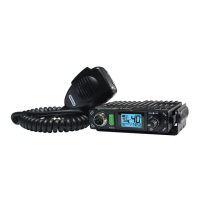
Do you have a question about the PRESIDENT BILL II FCC and is the answer not in the manual?
| Type | CB Radio |
|---|---|
| Frequency Range | 26.965 - 27.405 MHz |
| Number of Channels | 40 |
| Operating Modes | AM/FM |
| Antenna Impedance | 50 Ohms |
| Supply Voltage | 13.8 VDC |
| Modulation | AM / FM |
| Weight | 0.9 kg |
| Output Power | 4 Watts AM/FM |
Before using, be careful never to transmit without first having connected the antenna or without having set the SWR. Failure to do so may result in destruction of the power amplifier.
Guidance on choosing the best location and avoiding interference with the driver or passengers.
Instructions for choosing and mounting mobile antennas, including ground plane considerations and drilling.
Guidance on installing fixed antennas in clear spaces and seeking professional advice.
Steps for connecting the CB radio to a 12V power supply, including battery terminal identification and polarity.
Essential steps like connecting the microphone, checking antenna, turning on, and setting volume/squelch.
Instructions for adjusting the Standing Wave Ratio (SWR) to ensure optimal transmission.
How to turn the unit on and adjust the sound level using the volume knob.
Understanding and adjusting Squelch for background noise reduction and Automatic Squelch Control (ASC).
How to select channels manually and activate the scan function for CB and Weather channels.
Explanation of the icons and symbols shown on the CB radio's display for various functions.
Switching between CB and Weather channels, and activating the emergency alert tone.
Using noise blanker, noise limiter, and high-cut filters for reception improvement.
How to skip channels during scanning, storing them in the SCAN SKIP memory.
Selecting AM/FM modulation and configuring VOX function parameters like sensitivity and delay.
Activating and selecting emergency channels for quick access during urgent situations.
Locking/unlocking the unit and using the USB port for charging external devices.
Details on the 6-pin microphone plug, Push-to-Talk switch, and Time Out Timer.
How to activate or deactivate the VOX (Voice Operated eXchange) function using the PTT switch.
Procedure for accessing and navigating the unit's menu system to change settings.
Customizing the display color of the CB radio, with options for different hues.
Enabling or disabling the audible beep confirmation for key presses.
Configuring the Roger Beep sound for transmission completion confirmation.
Assigning priority channels for emergency calls and setting up EMG1 and EMG2.
Selecting the correct microphone type (electret or dynamic) for optimal performance.
Adjusting the volume for external accessories plugged into the CB radio.
Memorizing or erasing channels from the scan skip memory for customized scanning.
Restoring factory settings or clearing the scan skip memory.
Details on channels, modulation, frequency ranges, weather channels, and antenna impedance.
Specifications for power supply, physical dimensions, weight, and supplied accessories.
Details on frequency allowance, carrier power, transmission interference, audio response, and emitted power.
Data on sensitivity, frequency response, audio power, squelch sensitivity, and rejection rates.
Solutions for problems related to not transmitting or poor transmission quality.
Troubleshooting steps for when the CB radio does not receive or has poor reception.
Checks to perform if the CB radio's display or lights are not working.
Guidance on the basic procedure for transmitting and receiving messages with the CB radio.
List of phonetic spellings for letters used in radio communication.
Definitions of common technical terms used in CB radio operation.
Common slang, abbreviations, and phrases used by CB radio operators.
Detailed wiring diagram and pinout for the 6-pin microphone connector.
Statements regarding antenna gain and type, and RF exposure limits for Canadian regulations.
Information on compliance with Industry Canada's license-exempt RSSs and radio regulations.
Statements regarding compliance with FCC Part 15 rules for harmful interference.
Information on modifications voiding authority and limits for Class B digital devices.
PRESIDENT ELECTRONICS USA head office address, website, phone number, and email.